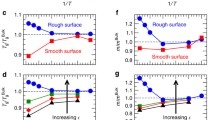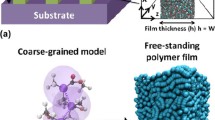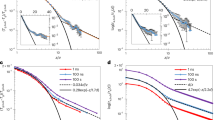Abstract
Freestanding thin polymer films with high molecular weights exhibit an anomalous decrease in the glass-transition temperature with film thickness. Specifically, in such materials, the measured glass-transition temperature evolves in an affine way with the film thickness, with a slope that weakly depends on the molecular weight. De Gennes proposed a sliding mechanism as the hypothetical dominant relaxation process in these systems, where stress kinks could propagate in a reptation-like fashion through so-called bridges, i.e. from one free interface to the other along the backbones of polymer macromolecules. Here, by considering the exact statistics of finite-sized random walks within a confined box, we investigate in details the bridge hypothesis. We show that the sliding mechanism cannot reproduce the basic features appearing in the experiments, and we exhibit the fundamental reasons behind such a fact.



Similar content being viewed by others
Data Availability
Data produced for this article are available upon reasonable request to the authors.
Change history
20 October 2023
A Correction to this paper has been published: https://doi.org/10.1140/epje/s10189-023-00351-1
References
H. Vogel, The law of the relationship between viscosity of liquids and the temperature. Phys. Z. 22, 645 (1921)
G.S. Fulcher, Analysis of recent measurements of the viscosity of glasses. J. Am. Ceram. Soc. 8(6), 339 (1925)
G. Tammann, W. Hesse, Die Abhängigkeit der Viscosität von der Temperatur bie unterkühlten Flüssigkeiten. Z. Anorg. Allg. Chem. 156, 245 (1926)
M.L. Williams, R.F. Landel, J.D. Ferry, The temperature dependence of relaxation mechanisms in amorphous polymers and other glass-forming liquids. J. Am. Chem. Soc. 77, 3701 (1955)
C.A. Angell, Formation of glasses from liquids and biopolymers. Science 267, 1924 (1995)
L. Berthier, G. Biroli, Theoretical perspective on the glass transition and amorphous materials. Rev. Mod. Phys. 83, 587 (2011)
M.D. Ediger, P. Harrowell, Perspective: supercooled liquids and glasses. J. Chem. Phys. 137 (2012)
G. Parisi, P. Urbani, F. Zamponi, Theory of Simple Glasses: Exact Solutions in Infinite Dimensions (Cambridge University Press, Cambridge, 2020)
P. Anderson, Through the glass lightly. Science 267, 1615 (1995)
G. Adam, J.H. Gibbs, On the temperature dependence of cooperative relaxation properties in glass-forming liquids. J. Chem. Phys. 43, 139 (1965)
E. Donth, Characteristic length of the glass-transition. J. Polym. Sci. B Polym. Phys. 34, 2881 (1996)
J.D. Stevenson, J. Schmalian, P.G. Wolynes, The shapes of cooperatively rearranging regions in glass-forming liquids. Nat. Phys. 2, 268 (2006)
A.J. Liu, S.R. Nagel, The jamming transition and the marginally jammed solid. Annu. Rev. Condens. Matter Phys. 1 (2010)
Z. Zhang, P.J. Yunker, P. Habdas, A.G. Yodh, Cooperative rearrangement regions and dynamical heterogeneities in colloidal glasses with attractive versus repulsive interactions. Phys. Rev. Lett. 107, 208303 (2011)
J. Bares, Glass transition of the polymer microphase. Macromolecules 8, 244 (1975)
C.L. Jackson, G.B. McKenna, The melting behavior of organic materials confined in porous solids. J. Chem. Phys. 93(12), 9002 (1990)
P. Scheidler, W. Kob, K. Binder, The relaxation dynamics of a simple glass former confined in a pore. Europhys. Lett. 52, 277 (2000)
L. Berthier, Finite-size scaling analysis of the glass transition. Phys. Rev. Lett. 91, 055701 (2003)
J.L. Keddie, R.A.L. Jones, R.A. Cory, Size-dependent depression of the glass transition temperature in polymer films. Europhys. Lett. 27(1), 59 (1994)
J.A. Forrest, K. Dalnoki-Veress, The glass transition in thin polymer films. Adv. Colloid Interface Sci. 94, 167 (2001)
F. Varnik, J. Baschnagel, K. Binder, Reduction of the glass transition temperature in polymer films: a molecular-dynamics study. Phys. Rev. E 65, 021507 (2002)
C.J. Ellison, J.M. Torkelson, The distribution of glass-transition temperatures in nanoscopically confined glass formers. Nat. Mater. 2, 695 (2003)
J. Baschnagel, F. Varnik, Computer simulations of super-cooled polymer melts in the bulk and in confined geometry. J. Phys.: Condens. Matter 17, R851 (2005)
M. Alcoutlabi, G.B. McKenna, Effects of confinement on material behaviour at the nanometre size scale. J. Phys.: Condens. Matter 17, R461 (2005)
Z. Fakhraai, J.A. Forrest, Measuring the surface dynamics of glassy polymers. Science 319, 600 (2008)
Z. Yang, Y. Fujii, F.K. Lee, C.-H. Lam, O.K.C. Tsui, Glass transition dynamics and surface layer mobility in unentangled polystyrene films. Science 328, 1676 (2010)
Y. Chai, T. Salez, J.D. McGraw, M. Benzaquen, K. Dalnoki-Veress, E. Raphaël, J.A. Forrest, A direct quantitative measure of surface mobility in a glassy polymer. Science 343, 994 (2014)
H. Yoon, G.B. McKenna, Substrate effects on glass transition and free surface viscoelasticity of ultrathin polystyrene films. Macromolecules 47, 8808 (2014)
M.D. Ediger, J.A. Forrest, Dynamics near free surfaces and the glass transition in thin polymer films: a view to the future. Macromolecules 47, 471 (2014)
K. Ngai, A. Rizos, D. Plazek, Reduction of the glass temperature of thin freely standing polymer films caused by the decrease of the coupling parameter in the coupling model. J. Non-Cryst. Solids 235, 435 (1998)
D. Long, F. Lequeux, Heterogeneous dynamics at the glass transition in van der Waals liquids, in the bulk and in thin films. Eur. Phys. J. E 4, 371 (2001)
S. Herminghaus, K. Jacobs, R. Seemann, The glass transition of thin polymer films: some questions, and a possible answer. Eur. Phys. J. E 5, 531 (2001)
J.E.G. Lipson, S.T. Milner, Percolation model of interfacial effects in polymeric glasses. Eur. Phys. J. B 72, 133 (2009)
J.A. Forrest, What can we learn about a dynamical length scale in glasses from measurements of surface mobility? J. Chem. Phys. 139, 084702 (2013)
C.-H. Lam, O.K. Tsui, Crossover to surface flow in supercooled unentangled polymer films. Phys. Rev. E 88, 042604 (2013)
J.A. Forrest, K. Dalnoki-Veress, When does a glass transition temperature not signify a glass transition? ACS Macro Lett. 3, 310 (2014)
S. Mirigian, K.S. Schweizer, Communication: slow relaxation, spatial mobility gradients, and vitrification in confined films. J. Chem. Phys. 141, 161103 (2014)
T. Salez, J. Salez, K. Dalnoki-Veress, E. Raphaël, J.A. Forrest, Cooperative strings and glassy interfaces. Proc. Natl. Acad. Sci. 112, 8227 (2015)
Z. Hanakata, B.A. Pazminõ Betancourt, J.F. Douglas, F.W. Starr, A unifying framework to quantify the effects of substrate interactions, stiffness, and roughness on the dynamics of thin supported polymer films. J. Chem. Phys. 142, 234907 (2015)
M. Arutkin, E. Raphaël, J.A. Forrest, T. Salez, Cooperative strings and glassy dynamics in various confined geometries. Phys. Rev. E 101, 032122 (2020)
G. Reiter, M. Hamieh, P. Damman, S. Sclavons, S. Gabriele, T. Vilmin, E. Raphaël, Residual stresses in thin polymer films cause rupture and dominate early stages of dewetting. Nat. Mater. 4, 754 (2005)
K. Dalnoki-Veress, J.A. Forrest, P.-G. de Gennes, J.R. Dutcher, Glass transition reductions in thin freely-standing polymer films: a scaling analysis of chain confinement effects. J. Phys. IV 10, 221 (2000)
J.A. Forrest, K. Dalnoki-Veress, The glass transition in thin polymer films. Adv. Coll. Interface Sci. 94, 167 (2001)
C.B. Roth, J.R. Dutcher, Glass transition temperature of freely-standing films of atactic poly (methyl methacrylate). Eur. Phys. J. E 12, 103 (2003)
C.B. Roth, A. Pound, S.W. Kamp, C.A. Murray, J.R. Dutcher, Molecular-weight dependence of the glass transition temperature of freely-standing poly(methyl methacrylate) films. Eur. Phys. J. E 20, 441 (2006)
S. Kim, J.M. Torkelson, Distribution of glass transition temperatures in free-standing, nanoconfined polystyrene films: a test of de Gennes’ sliding motion mechanism. Macromolecules 44, 4546 (2011)
M. Aubouy, M. Manghi, E. Raphaël, Interfacial properties of polymeric liquids. Phys. Rev. Lett. 84, 4858 (2000)
J.E. Pye, C.B. Roth, Two simultaneous mechanisms causing glass transition temperature reductions in high molecular weight freestanding polymer films as measured by transmission ellipsometry. Phys. Rev. Lett. 107, 235701 (2011)
O. Tsui, Anomalous dynamics of polymer films, in Polymer Thin Films, World Scientific, p. 267 (2008)
O. Bäumchen, J.D. McGraw, J.A. Forrest, K. Dalnoki-Veress, Reduced glass transition temperatures in thin polymer films: surface effect or artifact? Phys. Rev. Lett. 109, 055701 (2012)
D.L. Baker, M. Reynolds, R. Masurel, P.D. Olmsted, J. Mattsson, Cooperative intramolecular dynamics control the chain-length-dependent glass transition in polymers. Phys. Rev. X 12, 021047 (2022)
P.-G. de Gennes, Glass transitions in thin polymer films. Eur. Phys. J. E 2, 201 (2000)
P.-G. de Gennes, Glass transitions of freely suspended polymer films. Comptes Rendus de l’Académie des Scienes 1(IV), 1179 (2000)
S.T. Milner, J.E. Lipson, Delayed glassification model for free-surface suppression of Tg in polymer glasses. Macromolecules 43, 9865 (2010)
J.E. Lipson, S.T. Milner, Local and average glass transitions in polymer thin films. Macromolecules 43, 9874 (2010)
M. Doi, S.F. Edwards, The Theory of Polymer Dynamics (Oxford University Press, Oxford, 1988), p.73
S. Redner, A Guide to First-Passage Processes (Cambridge University Press, Cambridge, 2001)
Acknowledgements
The authors acknowledge financial support from the European Union through the European Research Council under EMetBrown (ERCCoG-101039103) grant. The authors also acknowledge financial support from the Agence Nationale de la Recherche under EMetBrown (ANR-21-ERCC-0010-01), Softer (ANR-21-CE06-0029) and Fricolas (ANR-21-CE06-0039) grants, as well as from the UHJ-France association and the Scopus Foundation. Finally, they thank the Soft Matter Collaborative Research Unit, Frontier Research Center for Advanced Material and Life Science, Faculty of Advanced Life Science at Hokkaido University, Sapporo, Japan, as well as the Natural Sciences and Engineering Research Council of Canada.
Author information
Authors and Affiliations
Contributions
JF, ER and TS conceived the study. HB and MA performed the analytical research. RC performed the numerical simulations. HB wrote the first draft of the manuscript. All the authors discussed the results and contributed to the writing of the manuscript.
Corresponding author
Additional information
For Fyl, who has always encouraged the young and not-so-young people around him to be inventive and to have fun in their pursuit of science.
The original online version of this article was revised: “A dedication to the collection: Festschrift in honor of Philip (Fyl) Pincus has been added”.
Rights and permissions
Springer Nature or its licensor (e.g. a society or other partner) holds exclusive rights to this article under a publishing agreement with the author(s) or other rightsholder(s); author self-archiving of the accepted manuscript version of this article is solely governed by the terms of such publishing agreement and applicable law.
About this article
Cite this article
Bonneau, H., Arutkin, M., Chen, R. et al. On the bridge hypothesis in the glass transition of freestanding polymer films. Eur. Phys. J. E 46, 8 (2023). https://doi.org/10.1140/epje/s10189-023-00272-z
Received:
Accepted:
Published:
DOI: https://doi.org/10.1140/epje/s10189-023-00272-z




